What are the most important factors in having youthful, healthy skin? Probably hydration, plumpness and elasticity. Now the harder question: How can you acquire these things, especially as aging takes a toll on all of them? The answer may be a combination approach, with both topical and internal products playing important roles.
“Like all tissues and organs in our body, skin gets nutrients from our diet through the bloodstream,” points out Andreas M. Papas, Ph.D., author of The Vitamin E Factor, editor of Antioxidant Status and adjunct professor at East Tennessee State University. “In addition, we can nourish the skin with external application of creams, lotions and other products.”
But, due to absorption issues and the suitability of topical delivery for certain nutrients (like omega-3 fatty acids, carotenoids or large molecules), inside–outside supplements are definitely important options for shoppers to know about.
Soaking in Extra MoistureWhen skin gets dry and irritated many shoppers reach for their favorite creams and lotions and load up on drinking water. Both are good ideas, but many times a companion beauty-from-within supplement can be a great way to keep skin hydrated.
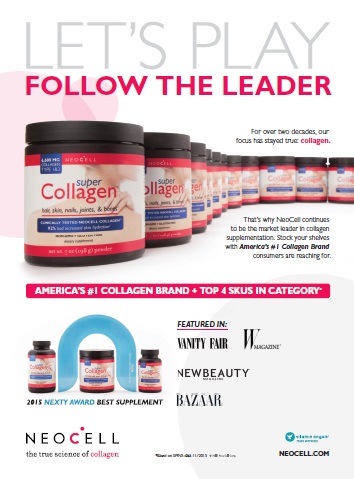 Hyaluronic acid, a “moisture magnet,” is commonly used for this purpose. According to Steve Holtby, president and CEO, Soft Gel Technologies, Inc., Los Angeles, CA, hyaluronic acid binds to water, helps retain it and has “instructive effects on cell signaling and behavior (adhesion, migration and proliferation).”
Hyaluronic acid, a “moisture magnet,” is commonly used for this purpose. According to Steve Holtby, president and CEO, Soft Gel Technologies, Inc., Los Angeles, CA, hyaluronic acid binds to water, helps retain it and has “instructive effects on cell signaling and behavior (adhesion, migration and proliferation).”When you look at the research on hyaluronic acid, it suggests that 1,500 mg/day helps with hydration of the cells, says Audrey Ross, N.D., western regional educator at Country Life Vitamins, Hauppauge, NY. She believes combining hyaluronic acid with adequate amounts of drinking water will make a big difference in maintaining hydrated skin.
A clinical study involving a branded hyaluronic acid (Injuv from Soft Gel Technologies, Inc.) was conducted on 107 volunteers (ages 30–50) (1). For a month, individuals took two 70-mg soft gels twice daily or a placebo. Skin moisture was measured before and after supplementation using an SHP88 probe. According to Holtby, “Subjects who took Injuv showed a statistically significant increase in skin moisture content compared to both baseline and placebo. There were no adverse events reported” (see Figure 1).
In another study, 96 women (ages 22–65) took the supplement (six 70-mg Injuv tablets daily) for 45 days (2). Questionnaires revealed: • 84% reported a great improvement in the moisture levels of their hands and face. • 83% reported a great improvement in the smoothness of their skin. • 78% reported a great improvement in the softness of their elbows, knees and hands. • 50% reported a great improvement in the stiffness of their joints.
Meanwhile,ceramides—biolipids present in the top layers of our skin—create a protective barrier and “play a huge role in water retention and skin hydration,” says Rob Maru, chief innovation officer at Reserveage Nutrition, Boca Raton, FL.
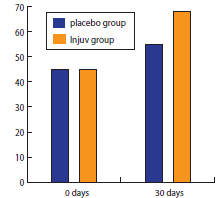
He speaks of one branded wheat-derived ceramide (Ceramosides from SEPPIC Inc.) that combines phytoceramides and digalactosyl diglycerides (DGDG). According to Maru, one study on the ingredient found “hydrating effects starting in just 15 days.” After 60 days, even more noticeable effects were found, like increased skin moisture, increased skin smoothness and reduced skin roughness.
Tim Mount, CN, CCMH, director of education at NeoCell, Irvine, CA, calls hyaluronic acid and ceramides “two superstar nutrients for skin hydration.”
He explains that the two nutrients work well as a pair: “hyaluronic acid at the deeper layers of the skin draws in long-lasting hydration, and ceramides at the surface of the skin act as a barrier to reduce water loss from the skin.”
The benefits of supplementing with both nutrients become especially important with age, says Mount. Over time, the skin produces less hyaluronic acid and ceramides break down, which he says is a big contributor to the dryness we often see in mature skin. “By replenishing hyaluronic acid and rebuilding the ceramide barrier through supplementation, we have a solution to reduce or reverse this aging process,” says Mount. “Less fine lines and wrinkles are visible because of the plumping affect of increased skin hydration, and our skin looks softer and more youthful.”
In addition to boosting hyaluronic acid in the body by supplementing with it directly, taking French maritime pine bark extractmay be an option. Sébastien Bornet, vice president of global sales and marketing at Horphag Research (exclusive worldwide supplier of Pycnogenol), Hoboken, NJ says his company’s branded version (Pycnogenol) is “the only natural supplement that has been demonstrated via clinical study to increase the expression of hyaluronic acid synthase and collagen production in human skin.”
In this study, 20 postmenopausal women took Pycnogenol for 12 weeks, and their skin was analyzed before, during and after the trial (3). The researchers found, “Pycnogenol significantly improved hydration and elasticity of skin,” with the best results in women who had dry skin before the study.
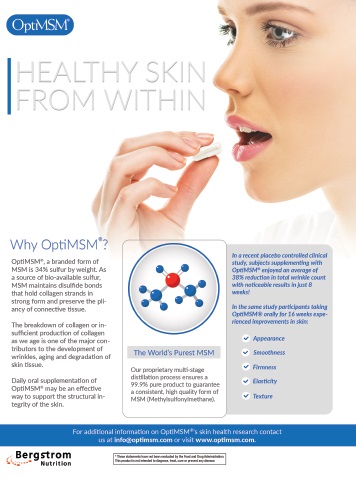 The group also found a significant increase in the mRNA expression of hyaluronic acid synthase-1. This enzyme is involved in hyaluronic acid production, which benefits hydration. According to Bornet, Pycnogenol caused a 44% increase in hyaluronic acid after 12 weeks of supplementation while skin elasticity increased 25%, skin fatigue decreased 30% and skin hydration increased 8%. Those with dry skin from the start had a 21% increase in moisture.
The group also found a significant increase in the mRNA expression of hyaluronic acid synthase-1. This enzyme is involved in hyaluronic acid production, which benefits hydration. According to Bornet, Pycnogenol caused a 44% increase in hyaluronic acid after 12 weeks of supplementation while skin elasticity increased 25%, skin fatigue decreased 30% and skin hydration increased 8%. Those with dry skin from the start had a 21% increase in moisture.Collagenis another factor in hydration. In fact, Suhail Ishaq, president of BioCell Technology, LLC, Newport Beach, CA, calls collagen one of the “current go-to nutricosmetics for skin hydration.”
He says that a branded collagen ingredient from his company (BioCell Collagen) was studied for its benefits on this very front. The study included 26 healthy women with photodamaged facial skin. After taking one gram of the collagen supplement daily for three months, skin dryness and scaling dropped 76% and the appearance of wrinkles was reduced by 13% over baseline (4).
Takingomega-3sis also a good way to support hydrated skin, with Nick Bitz, chief scientific officer at Nutrawise/Youtheory, Tustin, CA, suggesting 1,000 mg of DHA and EPA daily, to “help to optimize cellular structure/function.”
Papas believesvitamin E is worth exploring for hydration. “Vitamin E has been shown to increase stratum corneum hydration and enhance its water-binding capacity,” he states. “In addition, as a lipophilic vitamin with a major role in reducing oxidative stress and inflammation, it plays a key role in normal hydration of the skin.”
Another antioxidant that's key for hydrationastaxanthin. "Research has shown that astaxanthin, when taken alone or combined with tocotrienols, can help improve skin hydration," states Gerry Cysewski, Ph.D., interim chief executive officer and chief science officer for Cyanotech Corporation.
In one six-week study of 28 participants taking 4 mg per day of astaxanthin, skin hydration nd elasticity were significantly improved.
Probioticsis another up-and-coming ingredient for skin health. Among the many potential applications is moisturization. Mike Bush, senior vice president for Ganeden, Mayfield Heights, OH, says a branded topical probiotic from his company demonstrated anti-aging benefits in a study: “Bonicel was also shown to increase moisturization of the skin by 19.10%.”
Meanwhile,methylsulfonylmethane(MSM, as OptiMSM from Bergstrom Nutrition) was found in a recent study fromNatural Medicine Journal (5) to regulate the expression of genes responsible for skin health and premature aging like those involved in inflammation and moisturization. It also was found to improve crow’s feet, skin firmness, tone and texture.
Problem Skin? Help From WithinItchy, dry skin isn’t fun when it happens from harsh winter conditions, lack of hydration or another environmental factor. But for millions of Americans, chronic skin conditions like eczema—often resulting in dryness and flaking—are an unpleasant fact of everyday life.
Says Mark McKnight, senior vice president of sales for RiceBran Technologies, Phoenix, AZ, “Hydration is extremely important for clearing up any type of skin condition.” For this reason, several of the aforementioned nutrients may be helpful, though supplements will not be able to cure, treat or prevent any disease or illness.
But, not all chronic and problematic skin issues are related to hydration. Take acne, for instance. This issue may be related to inflammation and free radical damage.
According to Papas, free radicals damage the first molecule in their path, whether it is fat, protein, DNA,
|
The Truth About Collagen Supplements
Three Revelations from an Industry Insider
By Rob MaruCollagen. It’s a word we’ve seen in glossy ads baring smooth, younger-looking skin. Recently, collagen supplements have stolen the spotlight with an enticing message: supporting beautiful skin from within. Curious, the health-conscious public has taken notice and is asking the obvious question. Do collagen supplements work?Spanning over 15 years, I have formulated dozens of nutritional and herbal products including two lines of collagen supplements for Reserveage Nutrition, and have had affiliations with the industry’s most recognizable names. So I’m comfortable going on record by saying: Some show promise; others fall flat. Why Collagen Matters Collagen is a heavy-duty network of connective proteins found in skin, joints, tendons and other body tissue. In skin, collagen contributes to its firmness and radiance. As we age, collagen synthesis declines contributing to recognizable signs of visible aging such as wrinkles, sagging and loss of elasticity. To counter collagen loss, it’s important to replenish the nutrients and building blocks that the body may use to support collagen renewal, among other things. In practice, when you find yourself in the vitamin aisle dutifully reading one label after another searching for the right one, really, how do you choose? Collagen Supplements Are Not All the Same When I speak at industry events on the subject, I begin with similarities between collagen ingredients, which are generally derived from the same type of source such as bovine, porcine or poultry. Formulas come in capsules, powders and even tasty chews. That’s where the similarities end. Three traits I look for in assessing a collagen ingredient: Traceable source, reputable ingredient supplier and scientific studies on the ingredient. The quality of a collagen ingredient is based upon the quality of the original source of collagen, its handling as it is processed and the batch-to-batch consistency of the finished collagen material. By sourcing collagen material from a supplier with a good reputation in the industry, we are assured that the material has been adequately tested throughout the processing of the collagen. Some of the most reputable collagen ingredients I’ve found that offer traceability and consistency batch to batch are Verisol Bioactive Peptides and BioCell Collagen. Is it “body ready”? Many collagen ingredients often undergo a process that produces smaller-sized molecules the body can easily absorb. Verisol Bioacive Peptides and Biocell Collagen each have a different patented process to produce smaller sized molecules from high-quality collagen sources. The recommended serving sizes—Verisol at 2.5 grams and BioCell at 1 gram for skin or 2 grams for joints—translate to fewer capsules and smaller serving sizes. Scientifically tested. In considering which collagen ingredient to use, I look at whether there are any published scientific studies conducted on the collagen ingredient and, if so, the quality of the studies. My background offers me a unique vantage point into collagen supplements that few shoppers would have. As these products gain mainstream approval, and as questions about them go unanswered, it is the collective responsibility of our industry to educate the marketplace on how to make a confident and informed decision. Rob Maru is the chief innovation officer at Reserveage Nutrition. |
|
To reduce free radical production and inflammation, Papas suggests the “use of strong, natural anti-inflammatory compounds that act synergistically or complement the function of antioxidants and enable the effective management of inflammation.” While supplements cannot be said to offer anti-inflammation effects or treat diseases, they do help support a balanced inflammatory response.
Papas recommendsvitamin Egamma tocopherol and tocotrienols for this purpose, especially as a mixed tocopherol–tocotrienols formula. He calls gamma-tocopherol an important quencher of nitrogen radicals and a supporter of healthy inflammatory responses in the body. He states, “Research by the Armed Forces Radiobiology Research Institute showed that tocotrienols and particularly gamma and delta provide powerful protection against radiation damage. Alpha-tocotrienol is being evaluated in a clinical study for its wound-healing properties. Tocotrienols accumulate preferentially in the skin.”
According to Holtby, dietaryomega-3 fats can also help. “High levels of omega-3 fatty acids have been shown to decrease inflammation, and may reduce the risk of acne and other skin problems by decreasing insulin-like growth factor (IGF-1) and preventing hyperkeratinization of sebaceous follicles,” he states.
Eczema is another example. This inflammatory skin condition can be affected by allergens, microbes, temperature, certain food, stress and more. Bumping up the hydration and the inflammation support may help individuals affected by this condition. Oneomega-6 supplement that may help is gamma-linolenic acid (GLA), sourced from items like evening primrose (EPO), borage oil, and black currant seed oil. According to Holtby, “In the body, GLA is converted to a hormone-like substance called prostaglandin E1, which has anti-inflammatory properties. Some, but not all, clinical trials have shown that EPO and borage oil are useful in the treatment of eczema.”
Others have found benefits with using the omega-3 EPA, perhaps because it helps reduce pro-inflammatory leukotriene B4, which plays a role in the appearance eczema symptoms (6).French maritime pine bark extract may also be helpful, given its inflammation-support benefits. Bornet says a branded extract from his company (Pycnogenol) has been studied on those with psoriasis, an autoimmune disease linked to inflammation. “A recent study found daily supplementation with Pycnogenol to be effective in significantly improving symptoms of psoriasis including redness, skin hardening and flaking without side effects,” he explains.
For 12 weeks, researchers gave psoriasis sufferers 150 mg of Pycnogenol or a placebo daily (7). The Pycnogenol group had fewer areas of the body affected by psoriasis and severity improved. Moisture content also improved in the Pycnogenol group. The researchers stated, “These results indicate the efficacy of Pycnogenol supplementation in improving control of the most common clinical aspects of psoriasis and in reducing oxidative stress.”
Astaxanthinis another supplement to consider. Joe Kuncewitch, national sales manager for AstaReal USA, Burlington, NJ, says, “Clinical studies show that astaxanthin treatment improves the roughness, dryness and sebum balance of the outermost layer of the skin.”
Kuncewitch explains that astaxanthin not only supports healthy skin hydration, but also “increases the size of corneocytes, boosting the moisture retention and barrier strength of the skin surface.” He adds that clinical studies suggest that astaxanthin “promotes skin smoothness through the healthy maturation of the cornified envelope, which forms the main protective barrier for the skin.”
Meanwhile, Ishaq believes thatcollagen(as BioCell Collagen) is important because it encourages the regeneration of skin’s connective tissues and components like collagen, hyaluronic acid and other glycosaminoglycans. “Improved overall skin health will naturally help with things like acne where processes of infected cell healing will be accelerated,” he states, adding, “The same goes for psoriasis and eczema where a healthier skin tissue will result in less dead tissue buildup or with rosacea, which results from skin inflammation.”
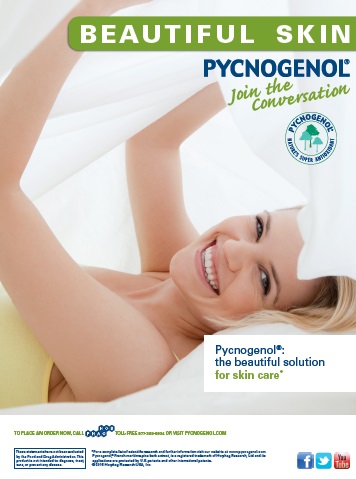 Last,probioticsmay also be a possibility for benefiting those with skin issues. In one study, maternal supplementation with Lactobacillus rhamnosus HN001 (6 × 109 CFU/day) from 35 weeks gestation until the baby was six months old (if breastfeeding) and infant supplementation from birth until two years old “halved the cumulative prevalence of eczema at two and four years” (8).
Last,probioticsmay also be a possibility for benefiting those with skin issues. In one study, maternal supplementation with Lactobacillus rhamnosus HN001 (6 × 109 CFU/day) from 35 weeks gestation until the baby was six months old (if breastfeeding) and infant supplementation from birth until two years old “halved the cumulative prevalence of eczema at two and four years” (8).Bush mentions that a topical probiotic from his company (Bonicel, derived from GanedenBC30 [Bacillus coagulans GBI-30, 6086]) may increase moisture and decrease redness, which may be of interest to individuals with certain skin conditions.
Too Much Sun Is No FunOverexposure to ultraviolet light can be extremely damaging to the skin. While nutrients have not been found in studies to prevent or treat sun damage, supplementation may play a supportive role when the skin is exposed to the sun in addition to using protective clothing and sunblock. Kuncewitch says that some nutrients (unlike topical) provide benefits to all skin layers “thus promoting healthy, radiant skin from the inside out.”
Papas says that photoaging is responsible for 80% of premature aging that appears in the form of dryness, deep wrinkles, accentuated skin furrows, sagging, loss of elasticity and mottled pigmentation. The reason why, he explains, is that free radicals are produced as a result of ultraviolet (UV) radiation. “UVA rays, and to a lesser extent UVB rays, penetrate deep into our skin, damaging collagen and elastin fibers,” he states, explaining that since UVB rays are nearly 100 times more intense than UVA rays, “UVA ages the skin while UVB burns the skin.”
Prolonged exposure to UV light can cause inflammation and induce an immune response in the form of sunburn. This degrades collagen and elastin in the skin.
According to Mount, several nutricosmetic ingredients “have the potential to guard against sun damage or reverse damage that has already occurred.Collagenmay be the most promising ingredient of all,” Mount states.
This is interesting in light of the fact that Maru says, “Exposure to the sun’s UV rays is one of the biggest contributors to damaged skin collagen.”
Eight preliminary studies on hydrolyzed collagen back up this statement. “Sun damage appears to affect the collagen matrix that makes up the skin and a collagen supplement may be useful in rebuilding compromised tissue,” he states.
One study, for instance, found that photodamaged human skin often has less type I and type III collagen precursors in it. The researchers state, “It is likely that such changes in collagen precursors lead to reduced levels and/or altered organization of fibrillar collagen, and thus may contribute to the wrinkled appearance of photodamaged human skin” (9).
A separate study found “chronic sunlight exposure may be associated with an impediment to normal maturation of human dermal collagen resulting in tenuous amount of HHL. Thus, the process of photoaging in dermal collagen is different from that of chronologic aging in human skin” (10). HHL or histidinohydroxylysinonorleucine is collagen cross-link found in mature skin tissue.
Lara Niemann, marketing director of Americas at Gelita, Sergeant Bluff, IA, adds that collagen peptides may also benefit the skin after photodamage occurs because they support healthy hydration. “The skin suffers from a progressive loss of moisture and becomes increasingly dry. Specific collagen peptides can slow this process by reducing wrinkles and fine lines and improving the elasticity and firmness of skin,” she explains.
In addition, antioxidants may help reduce oxidative or environmental stress caused by the sun in skin cells. For instance,astaxanthinhas an impressive track record for supporting skin health in people who are regularly exposed to the sun. According to Bob Capelli, executive vice president of global marketing at AlgaeLife, Irvine, CA, “Animal trials from the last century were already showing that astaxanthin can protect from photodamage from the inside out. This has subsequently been documented in human clinical research.”
Astaxanthin is produced by the algae Haematococcus pluvialisto protect it from lack of hydration and ultraviolet exposure. In humans, it scavenges free radicals and helps protect the body against damage. It is also said to be a potent UVB absorber and a “natural sunscreen,” though it cannot be used in lieu of sunblock or be labeled with an FDA-approved SPF. One study found exposure to UV radiation after three weeks of taking four grams daily of astaxanthin resulted in less reddening of the skin (11). It also protected against DNA damage caused by UVA light exposure (11).
Meanwhile, Cysewski cites a study published in theJournal of Cosmetic Dermatology which "found that after three months of supplementation with astaxanthin there was a noticeable improvement in fine lines and appearance of skin exposed to sun. Ultrasound measurement also showed a 78% increase in skin density among those taking astaxanthin."
Kuncewitch explains that astaxanthin has a “unique molecular structure that allows it to reside in the cell membrane and to protect the inside and outside of cells from free radical attack.” When taken as a supplement, it supports all layers of the skin, offers protection from UV damage, reduces the appearance of fine lines and more.
Some immune-health darlings may also have some benefits for supporting healthy skin, even skin regularly exposed to the sun:zinc andvitamin C. According to Holtby, zinc may support the structure of proteins and cell membranes of skin cells, and may also protect against UV radiation. Meanwhile, vitamin C not only contributes to skin health in general and faster healing, but “it may also help prevent and treat UV-induced photodamage by acting as an antioxidant,” says Holtby.
Vitamin Eis another important anti-inflammatory agent for defending the skin against free radical damage, states Holtby. He believes that vitamin E is especially helpful when paired with selenium. “Vitamin E may also play a synergistic role with selenium in improving glutathione levels in the body, further increasing antioxidant activity,” he states. “Adequate levels of this vitamin in the skin may prevent inflammatory damage from sun exposure, helping to reduce the aging and skin cancer risk from excessive UV radiation.”
Meanwhile, Papas says that research carried out by the Armed Forces Radiobiology Research Institute, Uniformed Services University of the Health Sciences and the Winthrop P. Rockefeller Cancer Institute at the University of Arkansas for Medical Sciences suggest that vitamin Egamma-tocotrienol helps protect against radiation exposure. “It functions as an inhibitor of HMG-CoA reductase (the key enzyme in LDL cholesterol synthesis), which prevents the depletion of the nitric oxide synthase (NOS) cofactor BH4,” he explains. When NOS production is not functioning properly, excessive free radicals can be produced, which may damage tissue. “In addition to gamma-radiation, tocotrienols have been suggested to protect tissue from exposure to UV radiation,” he adds.
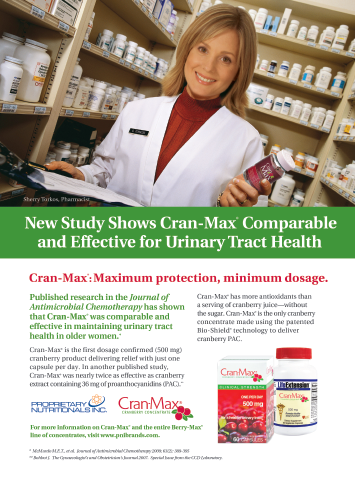 Mark Menolascino, M.D., key opinion leader with LycoRed, Orange, NJ, adds, “Lycopeneand the othercarotenoidsare great antioxidants for the skin and can be cross beneficial by providing a heart healthy anti-inflammatory state in the body. Lycopene also is my favorite ‘sun block from the inside’ as studies have shown lycopene levels correlate to protection from UV radiation from the sun.”
Mark Menolascino, M.D., key opinion leader with LycoRed, Orange, NJ, adds, “Lycopeneand the othercarotenoidsare great antioxidants for the skin and can be cross beneficial by providing a heart healthy anti-inflammatory state in the body. Lycopene also is my favorite ‘sun block from the inside’ as studies have shown lycopene levels correlate to protection from UV radiation from the sun.”Menolascino explains what could be behind some of these results: “Lycopene has the ability to protect the outer layers of the skin from oxidative damage from the sun and from pollution and it also forms a synergy with other antioxidants to keep the skin vibrant looking and protect from environmental stress.”
Other research has focused on the effect of other antioxidants. Says Bitz, “The prime example is Marigold extract, which contains lutein and zeaxanthin and is clinically studied for this purpose.”
Human studies have shown that these two nutrients are present in the skin, and animal studies suggest efficacy against UV light-induced skin damage (12).
For instance, one team of scientists exposed mice to low and high doses of UVB radiation several times a day to induce inflammation and immune suppression. Some mice were also fed lutein for two weeks. That group had less swelling than mice on a standard diet.
Michelle Baron, brand manager, innovation at Natrol LLC, Chatsworth, CA, is impressed withlutein. She says that in addition to protecting the skin against visible signs of aging caused by the sun and harsh environmental exposure, “clinical research has shown that the intake of 10 mg of lutein can help hydrate skin and improve skin elasticity to defy early signs of aging.”
Another important antioxidant for this discussion isFrench maritime pine bark. Bornet points to a recent review published in Skin Pharmacology showing, “Pycnogenol helps to inhibit UVA-induced upregulation of pigmentation markers by a 50–75% decrease, which further supports its ability to reduce hyperpigmentation.”
Bornet says prolonged exposure to UV light can cause inflammation and damage, and he believes Pycnogenol can help because “it inhibits the trigger (NF-kB), which governs the pro-inflammatory machinery in immune cells. Oral application of Pycnogenol to human volunteers was shown to significantly inhibit NF-kB by 15%.”
Choose Your Collagen WiselySeveral times in the piece, experts have mentioned collagen, which is certainly an “it” ingredient in the nutricosmetics category. But what distinguishes one supplement from another?
Retailers are probably familiar with the “types” of collagen available on the market (i.e., type 1, 2, 3). “This marketing has no doubt helped consumers dive deeper into the world of collagen, but it has also created much confusion,” Bitz believes.
He says that when marketers specify a product is “type 1 collagen,” they likely mean it is mainly derived from type 1 sources (like bovine hide). “They aren’t saying that the product has type 1 collagen in it per se,” he states.
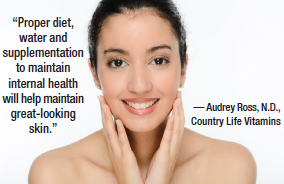
Bitz believes it is only important to indicate the collagen type when the collagen protein is in its native, undenatured, unaltered state. “When collagen protein is extracted, denatured and hydrolyzed for supplements, it’s no longer type 1, 2, 3…At this stage, it’s a homogenous blend of peptides and amino acids…[All hydrolyzed collagens] contain the same 18 key amino acids, with only a slight (and negligible) variance in the amino acid ratios.”
But this viewpoint is not without opposing views. Mount firmly believes that collagen type is important. He states, “The correct type of collagen should be used. Types 1 and 3 are the types of collagen found in the skin and are the best for skin and beauty products. Type 2 is only found in cartilage and is best for joint products.”
Experts do agree, however, that variations exist among various collagen supplements, says Bitz, such as the degree to which it is hydrolyzed (fully or partially), its hydroxyproline content and its purity.
Hydrolyzation is a major point of differentiation among products. States Ross, “A hydrolyzed peptide means it’s at its smallest molecular state so that the body can absorb it and use it very readily.” She explains that collagen in its natural form resembles a twisted rope. “Hydrolyzed is when that rope is pulled apart and chopped up into tiny little pieces to make it easier for the body to use it quicker,” Ross states.
Niemann believes how her firm’s collagen is cut into the smaller collagen peptides (average molecular weight of 2.0 kD) affects its efficacy for “triggering extracellular matrix formation—collagen and proteoglycans…Not all collagen peptides are optimized specifically for beauty from within applications; nor supported by science.”
Ishaq raises the point that the dosage of collagen will vary depending on the raw material’s bioavailability, with more bioavailable materials requiring smaller dosages. He believes that the particle sizes used in his company’s collagen (BioCell Collagen) “ensures low molecular weight fragments that are optimal for bioavailability.”
In the end, Ross believes a hydrolyzed format is the way to go for increased efficacy for those looking for
| Select Nutricosmetic Offerings |
AlgaeLife: AstaZine Natural Astaxanthin in several different organic and non-organic raw material forms.
Bergstrom Nutrition: OptiMSM.
BioCell Technology, LLC: BioCell Collagen.
Country Life Vitamins: Biotin, Maxi-Hair for Men, Maxi-Hair, Maxi-Skin and more.
Ganeden: Bonicel.
Gelita: Verisol.
Horphag Research: Pycnogenol.
LycoRed: Lycoderm and other Lycored and lutein ingredients.
Natrol: Biotin Plus and Skin, Hair and Nails.
NeoCell: Beauty Bursts Soft Gels, Fish Collagen +HA, Collagen Beauty Builder, Keratin Hair Volumizer, Beauty Infusion and more.
Nutrawise/Youtheory: Collagen, Collagen Powder, Collagen Liquid, Men’s Collagen, Resveratrol, Triphala, Turmeric, Hyaluronic Acid.
Nutrex Hawaii: BioAstin Hawaiian Astaxanthin.
Reserveage Nutrition: Collagen Booster, Collagen HydraProtect, Collagen Replenish and Plant Based Support Collagen Builder.
RiceBran Technologies: RiSolubles, RiFiber and RiBran.
Soft Gel Technologies, Inc.: Injuv, CoQsol, CoQsol-CF and EZ Mega 3.
more skin elasticity and less fine lines and wrinkles. She states, “We use a hydrolyzed peptide from Europe (Verisol). They have research that shows that in eight weeks, there’s a 60% increase in the dermis level of collagen at only 2.5 grams per day of types 1 and 3 collagen. These are the most predominant collagens in the skin.”
Of course, finished products will also vary in source and in dosage, and Bitz says taking at least 2.5 grams of hydrolyzed collagen per day will benefit the skin, while up to 10 grams supports bone and joint health. “We have found over time that six grams (of hydrolyzed collagen per day) is a good middle-of-the-road dosage for most people,” Bitz states.
Niemann seconds the idea of a 2.5-g daily dose of collagen, which she says is supported by two published clinical studies (on Verisol from Gelita). She adds, “Taken orally, they influence the skin’s (collagen) metabolism directly from the inside and can slow this process by reducing wrinkles and fine lines and improving the elasticity and firmness of skin.”
Mount offers some similar numbers. He feels at least 2,000 mg is appropriate for beauty benefits, “but higher is generally better. At NeoCell, our clinically proven dosage is 6,000 mg of types 1 and 3 hydrolyzed collagen.”
In addition, Maru recommends that retailers lean toward brands with adequate research backing and claims support. Whatever dose has yielded positive results in studies should be the same dosage used in the finished product.
Collagen supplements are also just as likely to be found in standalone products as they are in combination product, and McKnight believes both versions are effective. He states, “By combining collagen with other nutrients, such as stabilized rice bran along with vitamins A, E and D, you can support the structural strength of the skin and, at the same, time deliver vital micronutrients.”
Boosting collagen levels in the body can also be accomplished with nutrients found to support collagen production. • According to Bush, certainprobiotics(like Bonicel) increase the expression of a gene related to collagen production, “which provides further support that Bonicel may have skin firming and anti-wrinkle activity.” • Holtby suggests thatvitamin C plays a “crucial role in the regulation of the structural protein collagen, which is necessary for the extracellular stability of the skin.” • He adds thatsilicais also needed for normal collagen formation thanks to its interactions with glycosaminoglycans. •Sulfuris also needed for collagen synthesis. • Ishaq believeshydrolyzed collagen type II,hyaluronic acid and chrondroitin sulfate can all work together to support healthy collagen production. • Cysewski says one cannot ignoreastaxanthinin this area either. He says, "Astaxanthin is known as the most powerful antioxidant and when taken internally, it has been shown to stimulate collagen production in skin and joints." • And, Bornet believesFrench maritime pine bark (as Pycnogenol) can “boost collagen production and improve skin elasticity and overall smoothness.”
Mount points out that several of these items are building blocks that may affect one step in the creation of new collagen. Deficiencies in them will limit how much collagen can be made.WF
References
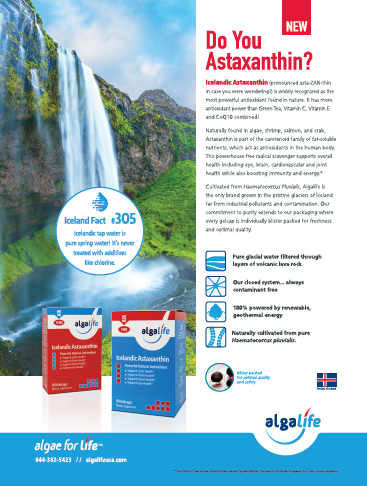
1. S. Wakayama, presenter, “Clinical Study On Injuv Demonstrates Improvement Of Skin Moisture Content,” poster presented at Nutracon and SupplyExpo, Anaheim, CA, March 2009. 2. S. Omori, “Clinical Trial on Injuv,” Otsuma Women’s University, Japan. Unpublished study performed 6/1/00-7/15/00. 3. A. Mariniet al.,“Pycnogenol Effects on Skin Elasticity and Hydration Coincide with Increased Gene Expressions of Collagen Type I and Hyaluronic Acid Synthase in Women,”Skin Pharmacol. Physiol. 25 (2), 86–92 (2012). 4. S.R. Schwartz and J. Park, “Ingestion of BioCell Collagen, A Novel Hydrolyzed Chicken Sternal Cartilage Extract; Enhanced Blood Microcirculation And Reduced Facial Aging Signs,”Clin. Interv. Aging7, 267–273 (2012). 5. M. Anthonavage, R. Benjamin and E. Withee, “Effects Of Oral Supplementation With Methylsulfonylmethane On Skin Health And Wrinkle Reduction: A Randomized, Placebo-Controlled, Double-Blind Clinical Pilot Study On OptiMSM,”Nat. Med. J. Vol. 7, Issue 11 (2015). 6. University of Maryland, “Eczema,”http://umm.edu/health/medical/altmed/condition/eczema,accessed 4/22/16. 7. G. Belcaroet al.,“Improvement In Signs And Symptoms In Psoriasis Patients With Pycnogenol Supplementation,”Panminerva Medica 56 (1), 41–48 (2014). 8. K. Wickenset al., “Early Supplementation withLactobacillus rhamnosus HN001Reduces Eczema Prevalence To 6 Years: Does It Also Reduce Atopic Sensitization?”Clin. Experimenal Allergy43 (9), 1048–1057 (2013). 9. Talwar HS1, Griffiths CE, Fisher GJ, Hamilton TA, Voorhees JJ. J Invest Dermatol. 1995 Aug;105(2):285-90. 10. Yamauchi M, Prisayanh P, Haque Z, Woodley DT. J Invest Dermatol. 1991 Nov;97(5):938-41. 11. “Want to Look Younger? Take Astaxanthin Every Day for 2 Weeks,” May 25, 2011,http://articles.mercola.com/sites/articles/archive/2011/05/25/sunscreen-and-wrinkle-prevention-in-a-pill.aspx,accessed Apr. 22, 2016. 12. R.L. Roberts, J. Green and B. Lewis, “Lutein and Zeaxanthin in Eye and Skin Health,”Clin. Dermatol. 27 (2), 195–201 (2009).
Published in WholeFoods Magazine June 2016










